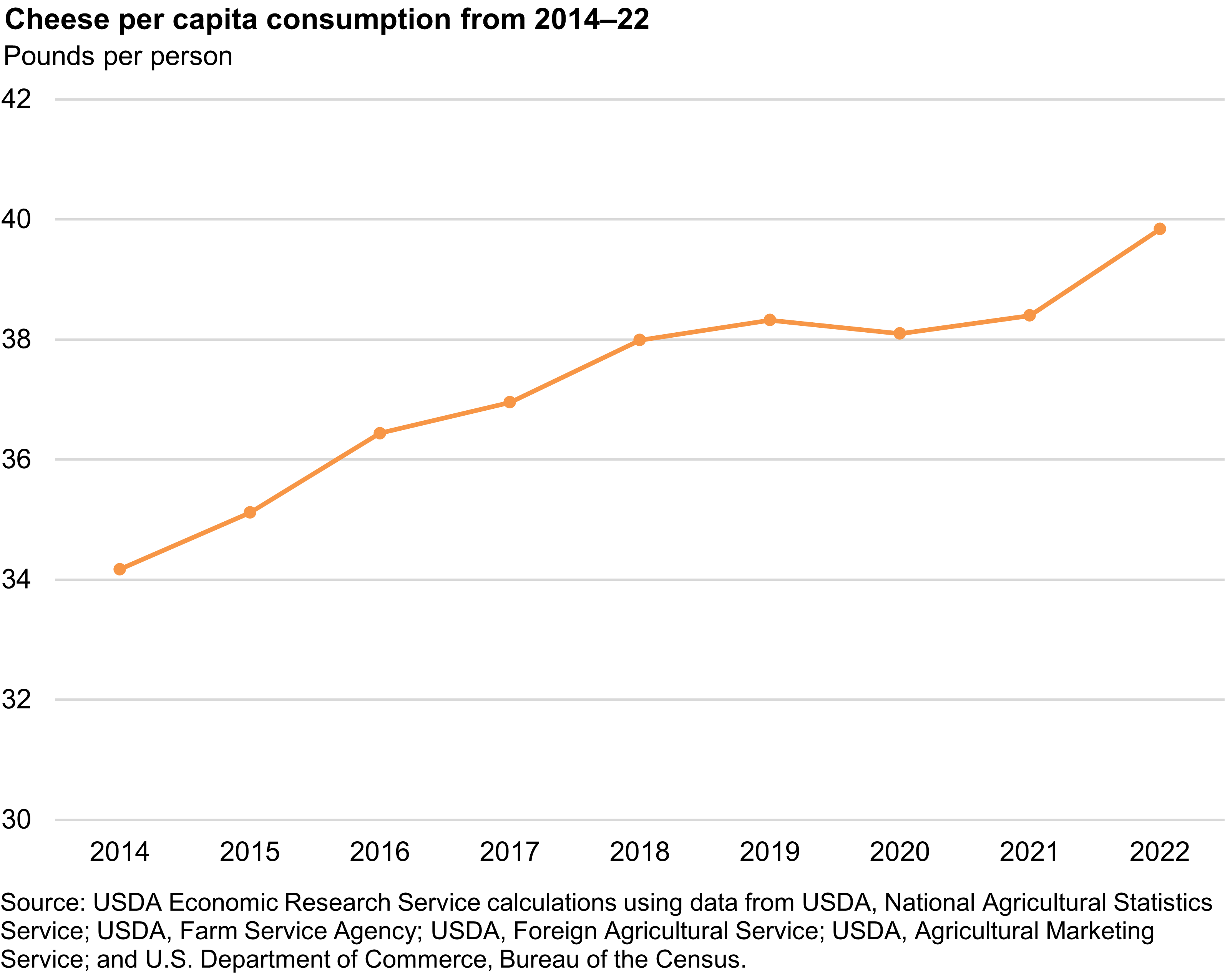Farm Milk Production
Major long-term trends in U.S. cows’ farm milk production include an increase in milk production and the consolidation of dairy farm operations. The top five milk production States in 2023 were California, Wisconsin, Idaho, Texas, and New York. Collectively, these 5 States produced more than 50 percent of the U.S. annual milk supply. In terms of production, milk cows generally perform best in areas with dry, cool weather. Most U.S. dairy cows are Holsteins, a breed that tends to produce more milk per cow than other breeds. However, Jersey and crossbreed cows have gained popularity in recent years, as milk from these breeds tends to contain relatively high proportions of milk fat and other milk solids compared with Holstein cows.

Download chart data in Excel format.
In the United States, most dairy operations are family owned. Many farmers belong to producer-owned cooperatives. The cooperatives assemble members' milk and move it to processors and manufacturers. Some of these dairy farm cooperatives have high vertical integration, operating their own processing and manufacturing plants. Although some dairy cooperatives cover a local or regional area, many dairy farmers across the country have become members of national cooperatives in recent years.
From Raw Milk to Dairy Products
In 2023, U.S. farm milk contained approximately 87 percent water, 4 percent milk fat, and 9 percent skim solids (i.e., protein, lactose, and minerals) on average. Milk is usually separated through various processes into components and processed into fluid beverage milk, cheese, and other dairy products.
Fluid milk faces a unique supply-demand situation not shared by most other food products. Cows continually produce milk, and their production varies by day, week, and season due to weather and other factors. Fluid milk demand varies by day and season because of consumer shopping patterns. Furthermore, milk is highly perishable. Due to these conditions, a system must be maintained to preserve the milk and make it accessible where and when it is needed most. Shipping milk among locations and storing it for 1 or 2 days solves some of the problem, but a pool of "on call" raw milk is ultimately needed. To balance the excess of raw milk, the portion of this reserve not needed for fluid milk processing products is cleared for the manufacturing of other dairy products.
Most of the milk supply is used to produce manufactured dairy products. Cheese makes up the largest portion of milk allocated for manufacturing purposes. When cheese is produced, a watery substance called whey is produced as a byproduct. Whey is often further processed into products such as dry whey, whey protein concentrate, and lactose. Other uses of milk include production of frozen products, butter, nonfat dry milk, yogurt, and other types of dairy products.
Consumption of Milk and Dairy Products
Milk components differ substantially among the various types of dairy products. To account for the uses of these components, USDA uses two ways to measure aggregate quantities of dairy products: (1) a milk-fat milk-equivalent basis and (2) a skim-solids milk-equivalent basis. Skim solids include protein, lactose, and minerals in dairy products.
From 2013 to 2023, U.S. consumption of total dairy products increased at compound annual growth rate (CAGR) of 1.45 per year on a milk-fat milk-equivalent basis and 0.93 percent per year on a skim-solids milk-equivalent basis.

Download chart data in Excel format.
However, the use of individual dairy products has shown great variation. For example, total U.S. per capita consumption of fluid milk has declined. Two factors contributing to the decline are increased competition from other beverages and a declining share of children in the population. Conversely, growing demand for cheese has been one of the most important forces shaping the U.S. dairy industry. Rising cheese consumption has been aided by the availability of a wider variety of cheeses, more away-from-home eating, and greater popularity of ethnic cuisines that employ cheese as a major ingredient. Mozzarella has been the most popular variety in recent years followed by Cheddar. Consumption of most varieties has grown steadily for many years, as cheese has become a very significant part of U.S. consumers’ diets.

Download chart data in Excel format.

Download chart data in Excel format.
For more information, see:
- USDA, Economic Research Service, Dairy Data
- USDA, Economic Research Service, Milk Cost of Production Estimates
- USDA, National Agricultural Statistics Service, Milk Production
- USDA, National Agricultural Statistics Service, Dairy Products
- USDA, Rural Development, Cooperative Services
